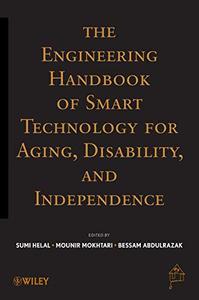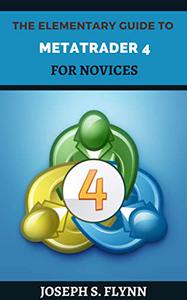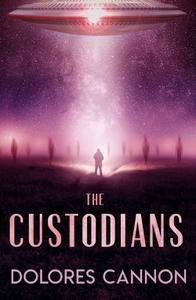

E-Books → The Engineering Handbook of Smart Technology for Aging, Disability, and Independence
Published by: voska89 on 2-08-2022, 19:32 |  0
0

The Engineering Handbook of Smart Technology for Aging, Disability, and Independence By
2008 | 940 Pages | ISBN: 0471711551 | PDF | 30 MB
An advanced look at smart technology to promote the independence of the elderly and disabled Ongoing research and advancements in technology are essential for the continuing independence of elderly and disabled persons. The Engineering Handbook of Smart Technology for Aging, Disability, and Independence provides a thorough analysis of these technologies and the needs of the elderly and disabled, including a breakdown of demographics, government spending, growth rate, and much more. Each chapter is written by an expert in his or her respective field, and gives readers unparalleled insight into the research and developments in a multitude of important areas, including: User-need analyses, classifications, and policies Assistive devices and systems for people with motor disabilities Assistive devices and systems for people with visual and hearing impairments Human-machine interaction and virtual reality Assistive robotics Technology for user mobility and object manipulation Smart homes as assistant environments A discussion of emerging standards and guidelines to build accessible devices, tools, and environments This book is an indispensable resource for researchers and professionals in computer science, rehabilitation science, and clinical engineering. It also serves as a valuable textbook for graduate students in the aforementioned fields.Content: Chapter 1 Technology for Successful Aging and Disabilities (pages 27-48): Amol Karmarkar, Eliana Chavez and Rory A. CooperChapter 2 International Policy Context of Technologies for Disabilities: An Analytic Framework (pages 49-59): Rene JahielChapter 3 Technology for Individuals with Disabilities: Government and Market Policies (pages 61-80): Katherine D. SeelmanChapter 4 Assistive Technology and the International Classification of Functioning, Disability, and Health (pages 81-99): Jerome E. BickenbachChapter 5 Technology for Integration of Students with Disabilities in Higher Education (pages 101-116): Marci Kinas Jerome, Kristine Neuber, Brianna Stegall, Anna Emenova and Michael BehrmannChapter 6 ISO 9999 Assistive Products for Persons with Disability: Classification and Terminology (pages 117-126): Ir. Theo BougieChapter 7 Low?Tech Assistive Technology (pages 127-142): Kathleen Laurin and Jill Sherman PleasantChapter 8 People with Visual Disabilities (pages 143-162): John Gill and Linda JolliffChapter 9 Assistive Devices for People with Visual Impairments (pages 163-189): John GillChapter 10 Assistive Devices for People with Hearing Loss (pages 191-202): Matthew H. BakkeChapter 11 People with Cognitive Disabilities (pages 203-215): Mary Kay Rizzolo and David BraddockChapter 12 Assistive Devices for People with Cognitive Impairments (pages 217-236): Helene Pigot, Jeremy Bauchet and Sylvain GirouxChapter 13 Computer Access in the Workplace (pages 237-261): Karen Milchus and Carrie BruceChapter 14 Platforms and Operating System Accessibility (pages 263-279): Barry Feigenbaum and Kip HarrisChapter 15 Voice Interactive Systems (pages 281-296): Rudzionis Algimantas, Kastytis Ratkevicius and Vytautas RudzionisChapter 16 The Communication Assistant (Alternative Communication) (pages 297-316): Leanne L. WestChapter 17 Wearable Systems Design Issues for Aging or Disabled Users (pages 317-338): Maribeth Gandy, Tracy Westeyn, Helene Brashear and Thad StarnerChapter 18 Tactile Displays (pages 339-352): Stephen A. Brewster, Steven A. Wall, Lorna M. Brown and Eve E. HogganChapter 19 Assistive Robotics for Independent Living (pages 353-374): Bessam Abdulrazak and Dr. Mounir MokhtariChapter 20 Mobile Platform?Based Assistive Robot Systems (pages 375-403): Zeungnam Bien, Kwang?Hyun Park, Myung Jin Chung, Dae?Jin Kim, Jin?Woo Jung, Pyung?Hun Chang and Jin?Oh KimChapter 21 Robot Therapy at Elder Care Institutions: Effects of Long?Term Interaction with Seal Robots (pages 405-418): Takanori Shibata and Kazuyoshi WadaChapter 22 Prostheses: Human Limbs and Their Artificial Replacements (pages 419-436): Richard F. ff. WeirChapter 23 Wheelchairs within the Context of Smart House Design (pages 437-457): Dimitar StefanovChapter 24 People with Special Needs and Traffic Safety (pages 459-477): Nahid Shahmehri, Ioan Chisalita and Johan AbergChapter 25 Blind Navigation and the Role of Technology (pages 479-500): Nicholas A. Giudice and Gordon E. LeggeChapter 26 Walker Systems (pages 501-518): Andrew RentschlerChapter 27 Accessible Public Transportation Services in America (pages 519-534): Katharine M. Hunter?ZaworskiChapter 28 Transportation Services in Europe (pages 535-548): Isabelle DussutourChapter 29 Transportation Services in Asia (pages 549-566): Joseph Kwan and Eric TamChapter 30 Modeling the Well?Being of Older People (pages 567-584): Andrew SixsmithChapter 31 Context Awareness (pages 585-605): Jadwiga Indulska and Karen HenricksenChapter 32 Middleware for Smart Spaces (pages 607-618): Daqing Zhang, Tao Gu and Manli ZhuChapter 33 Safety, Security, Privacy and Trust Issues (pages 619-629): Abdallah M'hamedChapter 34 Automated Medication Management Devices (pages 631-644): R. J. Davies, Christopher Nugent, D. D. Finlay, N. D. Black and D. CraigChapter 35 Virtual Companions (pages 645-671): Nahid Shahmehri, Johan Aberg and Dennis MaciuszekChapter 36 Textile Sensing and e?Textiles (Smart Textiles) (pages 673-692): Rita Paradiso, Nicola Taccini and Giannicola LorigaChapter 37 The Gator Tech Smart House: A Programmable Pervasive Space (pages 693-709): Dr. Sumi Helal, Raja Bose, Steven Pickles, Hicham Elzabadani, Jeffrey King and Youssef KaddourahChapter 38 Health Application and Telecare (pages 711-726): Mathijs Soede, Frank Vlaskamp and Charles WillemsChapter 39 Immersive Telecare for Assisting People with Special Needs (pages 727-736): Dr. Sumi Helal and Bessam AbdulrazakChapter 40 Smart Systems in Personal Transportation (pages 737-747): Aaron SteinfeldChapter 41 Tools for Studying Novel Proactive Healthcare Applications for Places of Living (pages 749-766): Stephen Intille and Kent LarsonChapter 42 Algorithms for Smart Spaces (pages 767-783): Diane J. Cook, G. Michael Youngblood and Gaurav JainChapter 43 User?Sensitive Design for Older and Disabled People (pages 785-802): Alan NewellChapter 44 Universal Design/Design for All: Practice and Method (pages 803-818): Edward SteinfeldChapter 45 Design for Well?Being (pages 819-832): Andreas Larsson and Tobias LarssonChapter 46 Technology Evaluation within Healthcare and Social Care (pages 833-853): Suzanne Martin, George Kernohan, Bernadette McCreight and Christopher NugentChapter 47 Usability in Designing Assistive Technologies (pages 855-866): Jean?Claude Sperandio and Marion WolffChapter 48 Smart Home and Health Telematics: Standards for and with Users (pages 867-906): Milan ErbesChapter 49 ICT Standardization for the Elderly and People with Disabilities in Japan (pages 907-920): Hajime Yamada
E-Books → The End of World War II in Europe The History of the Final Campaigns that Led to Nazi Germany's Surrender
Published by: voska89 on 2-08-2022, 19:32 |  0
0

The End of World War II in Europe: The History of the Final Campaigns that Led to Nazi Germany's Surrender by Charles River Editors
English | June 25, 2015 | ISBN: 1514692104 | 140 pages | EPUB | 4.66 Mb
*Includes pictures *Includes accounts of the fighting during D-Day, the Battle of the Bulge, the Battle of Berlin, and more. *Includes online resources and a bibliography for further reading *Includes a table of contents By the end of 1943, with Allied forces firmly established in Italy and the Soviets on the verge of turning the tide in Russia, the British and Americans began to Description the invasion that would liberate Europe from the Nazis. During the first half of 1944, the Americans and British commenced a massive buildup of men and resources in the United Kingdom, while Allied Supreme Commander Dwight D. Eisenhower and military brass planned the details of an enormous and complex amphibious invasion of Europe. Though the Allies used misinformation to try deceiving the Germans, the most obvious place for an invasion was just across the narrow English Channel, and the Germans had built coastal fortifications throughout France to protect against just such an invasion. The invasion across the Channel came in the early morning hours of June 6, 1944. That day, forever known as D-Day, the Allies commenced Operation Overlord by staging the largest and most complex amphibious invasion in human history. The complex operation would require tightly coordinated naval and air bombardment, paratroopers, and even inflatable tanks that would be able to fire on fortifications from the coastline, all while landing over 150,000 men across nearly 70 miles of French beaches. Given the incredibly complex plan, it's no surprise that General Eisenhower had already written a letter apologizing for the failure of the invasion, which he carried in his coat pocket throughout the day. After the successful amphibious invasion on D-Day in June 1944, the Allies began racing east toward Germany and liberating France along the way. It was Hitler's belief that by splitting the Allied march across Europe in their drive toward Germany, he could cause the collapse of the enemy armies and cut off their supply lines. Part of Hitler's confidence came as a result of underestimating American resolve, but with the Soviets racing toward Berlin from the east, this final offensive would truly be the last gasp of the German war machine, and the month long campaign was fought over a large area of the Ardennes Forest, through France, Belgium and parts of Luxembourg. From an Allied point of view, the operations were commonly referred to as the Ardennes Offensive, while the German code phrase for the operation was Unternehmen Wacht am Rhein ("Operation Watch on the Rhine"), with the initial breakout going under the name of "Operation Mist." Today, Americans know it best as the Battle of the Bulge. After resisting the German attack, the Allied armies began advancing, and with that, the race to Berlin was truly on. In April 1945, the Allies were within sight of the German capital of Berlin, but Hitler refused to acknowledge the collapsed state of the German military effort even at this desperate stage, and he confined himself to his Berlin bunker where he met for prolonged periods only with those that professed eternal loyalty, even to the point of death. In his last weeks, Hitler continued to blame the incompetence of military officers for Germany's apparent failings, and he even blamed the German people themselves for a lack of spirit and strength. As their leader dwelled in a state of self-pity, without remorse or mercy but near suicide, the people of Berlin were simply left to await their fate as Russians advanced from the east and the other Allies advanced from the west. The battle would technically begin on April 16, 1945, and though it ended in a matter of weeks, it produced some of the war's most climactic events and had profound implications on the immediate future. In the wake of the war, the European continent was devastated, leaving the Soviet Union and the United States as uncontested superpowers.
E-Books → The Emotional Cerebellum
Published by: voska89 on 2-08-2022, 19:31 |  0
0

The Emotional Cerebellum
English | 2022 | ISBN: 3030995496 | 754 Pages | PDF EPUB (True) | 34 MB
Emotions represent a critical aspect of daily life in humans. Our understanding of the mechanisms of regulation of emotions has increased exponentially these last two decades. This book evaluates the contribution of the cerebellum to emotion. It outlines the current clinical, imaging and neurophysiological findings on the role of the cerebellum in key aspects of emotional processing and its influence on motor and cognitive function and social behavior.
E-Books → The Elusive Promise of Indigenous Development Rights, Culture, Strategy
Published by: voska89 on 2-08-2022, 19:30 |  0
0

Karen Engle, "The Elusive Promise of Indigenous Development: Rights, Culture, Strategy"
English | 2010 | ISBN: 0822347695 | PDF | pages: 419 | 1.2 mb
Around the world, indigenous peoples use international law to make claims for heritage, territory, and economic development. Karen Engle traces the history of these claims, considering the prevalence of particular legal frameworks and their costs and benefits for indigenous groups. Her vivid account highlights the dilemmas that accompany each legal strategy, as well as the persistent elusiveness of economic development for indigenous peoples. Focusing primarily on the Americas, Engle describes how cultural rights emerged over self-determination as the dominant framework for indigenous advocacy in the late twentieth century, bringing unfortunate, if unintended, consequences.
E-Books → The Elementary Guide To Metatrader 4 For Novices
Published by: voska89 on 2-08-2022, 19:29 |  0
0

The Elementary Guide To Metatrader 4 For Novices by JOSEPH S. FLYNN
English | 2022 | ISBN: N/A | ASIN: B0B82RW7R3 | 65 pages | EPUB | 0.13 Mb
MT4 іѕ а very еаѕу рlаtfоrm fоr bоth trаdеrѕ аnd іnvеѕtоrѕ to еxесutе аnd mаnаgе mаrkеt роѕіtіоnѕ. MеtаTrаdеr 4 ѕuрроrtѕ dіffеrеnt trаdе еxесutіоn mоdеѕ аnd оrdеr tуреѕ. Thеrе аrе аlѕо ԛuісk trаdіng funсtіоnѕ thаt allow уоu tо execute trаdеѕ dіrесtlу frоm thе сhаrt wіth оnlу оnе сlісk.
E-Books → The Definitive Chief Financial Officer How They can Transform your Business
Published by: voska89 on 2-08-2022, 19:29 |  0
0

The Definitive Chief Financial Officer: How They can Transform your Business by Mark Gruner
English | June 25, 2020 | ISBN: N/A | ASIN: B08BX3GHXV | 120 pages | MOBI | 0.49 Mb
How to Succeed as a CFO and a finance Manager
E-Books → The Dancing Girls An absolutely gripping crime thriller with nail-biting suspense (Detective Jo Fournier Book 1)
Published by: voska89 on 2-08-2022, 19:28 |  0
0

M.M. Chouinard, "The Dancing Girls: An absolutely gripping crime thriller with nail-biting suspense (Detective Jo Fournier Book 1)"
English | 2019 | ISBN: 1538754460 | EPUB | pages: 320 | 0.4 mb
When victims are found in dancing poses, Detective Jo Fournier immediately sees the pattern, but how can a serial killer get to victims all over the country?
E-Books → The Custodians
Published by: voska89 on 2-08-2022, 19:28 |  0
0

The Custodians by Dolores Cannon
English | October 28th, 2021 | ISBN: 1886940045 | 556 pages | True EPUB | 1.11 MB
UFO Sightings and abductions by aliens were the beginning, the tip of the iceberg.
E-Books → The Court of Burgundy
Published by: voska89 on 2-08-2022, 19:27 |  0
0

Otto Cartellieri, "The Court of Burgundy"
English | ISBN: 0415868122 | 2014 | 354 pages | EPUB | 4 MB
Originally published between 1920-70, The History of Civilization was a landmark in early twentieth-century publishing. It was published at a formative time within the social sciences, and during a period of decisive historical discovery. The aim of the general editor, C.K. Ogden, was to summarize the most up to date findings and theories of historians, anthropologists, archaeologists and sociologists. This reprinted material is available as a set or in the following groupings:
E-Books → The Composition of the Gospel of Thomas Original Language and Influences
Published by: voska89 on 2-08-2022, 19:27 |  0
0

Simon Gathercole, "The Composition of the Gospel of Thomas: Original Language and Influences "
English | ISBN: 1107686164 | 2014 | 338 pages | PDF | 2 MB
This book addresses two central questions in current research on the Gospel of Thomas: what was its original language and which early Christian works influenced it? At present, theories of Thomas as a Semitic work abound. Simon Gathercole dismantles these approaches, arguing instead that Thomas is Greek literature and that the matter of Thomas's original language is connected with an even more controverted question: that of the relationship between Thomas and the canonical New Testament. Rather than being independent of Matthew, Mark and Luke (as in most Western Aramaic theories of Thomas) or thoroughly dependent on the four gospels (as in most Syriac approaches), Gathercole develops a newly refined approach to how Thomas is influenced by the Synoptic Gospels. Thomas can be seen to refer to Matthew as a gospel writer, and evidence is discussed showing that Thomas incorporates phraseology distinctive to Luke, while also extending that special Lukan language.



